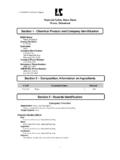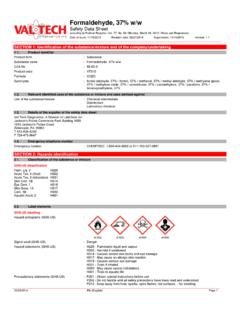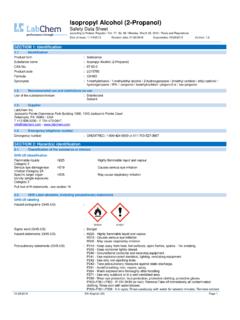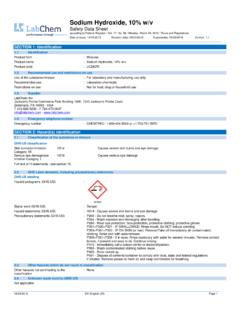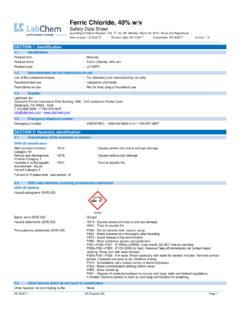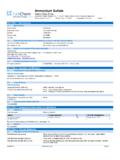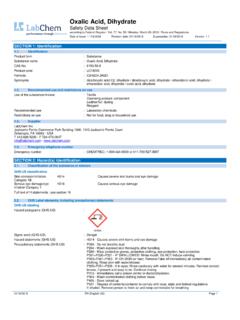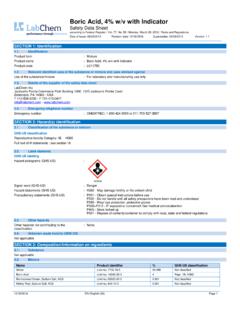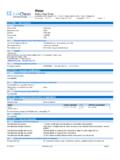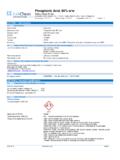Transcription of Acetone - labchem.com
1 Acetone safety data sheet according to Federal Register / Vol. 77, No. 58 / Monday, March 26, 2012 / Rules and Regulations Date of issue: 11/12/1998 Revision date: 09/20/2016 Supersedes: 10/01/2013 Version: 09/20/2016 EN (English US) Page 1 SECTION 1: Identification Identification Product form : Substance Substance name : Acetone Chemical name : 2-Propanone CAS No : 67-64-1 Product code : LC10420, LC10425 Formula : C3H6O Synonyms : 2-propanone / beta-ketopropane / dimethyl formaldehyde / dimethyl ketone / dimethylketal / DMK (=dimethyl ketone) / keto propane / methyl ketone / pyroacetic acid / pyroacetic ether / pyroacetic spirit Relevant identified uses of the substance or mixture and uses advised against Use of the substance/mixture : Solvent Cleaning product Chemical raw material Details of the supplier of the safety data sheet LabChem Inc Jackson's Pointe Commerce Park Building 1000, 1010 Jackson's Pointe Court Zelienople, PA 16063 - USA T 412-826-5230 - F 724-473-0647 - Emergency telephone number Emergency number : CHEMTREC: 1-800-424-9300 or 011-703-527-3887 SECTION 2: Hazard(s) identification Classification of the substance or mixture GHS-US classification Flammable liquids Category 2 H225 Serious eye damage/eye irritation Category 2A H319 Specific target organ toxicity (single exposure) Category 3 H336 Full text of H statements : see section 16 Label elements GHS-US labeling Hazard pictograms (GHS-US) : GHS02 GHS07 Signal word (GHS-US) : Danger Hazard statements (GHS-US).
2 H225 - Highly flammable liquid and vapor H319 - Causes serious eye irritation H336 - May cause drowsiness or dizziness Precautionary statements (GHS-US) : P210 - Keep away from heat, hot surfaces, open flames, sparks. - No smoking P233 - Keep container tightly closed P240 - Ground/bond container and receiving equipment P241 - Use explosion-proof electrical, lighting, ventilating equipment P242 - Use only non-sparking tools P243 - Take precautionary measures against static discharge P261 - Avoid breathing mist, spray, vapors P264 - Wash exposed skin thoroughly after handling P271 - Use only outdoors or in a well-ventilated area P280 - Wear eye protection, face protection, protective clothing, protective gloves P303 + P361 + P353 - IF ON SKIN (or hair): Remove/Take off immediately all contaminated clothing. Rinse skin with water/shower P304 + P340 - IF INHALED: Remove victim to fresh air and keep at rest in a position Acetone safety data sheet according to Federal Register / Vol.
3 77, No. 58 / Monday, March 26, 2012 / Rules and Regulations 09/20/2016 EN (English US) 2/9 comfortable for breathing P305+P351+P338 - If in eyes: Rinse cautiously with water for several minutes. Remove contact lenses, if present and easy to do. Continue rinsing P312 - Call a POISON CENTER or doctor/physician if you feel unwell P337 + P313 - If eye irritation persists: Get medical advice/attention P370 + P378 - In case of fire: Use dry chemical powder, alcohol-resistant foam, carbon dioxide (CO2) to extinguish P403 + P233 - Store in a well-ventilated place. Keep container tightly closed P405 - Store locked up P501 - Dispose of contents/container to comply with local, state and federal regulations P235 - Keep cool Other hazards Other hazards not contributing to the classification : None. Unknown acute toxicity (GHS US) Not applicable SECTION 3: Composition/Information on ingredients Substance Substance type : Mono-constituent Name Product identifier % GHS-US classification Acetone (Main constituent) (CAS No) 67-64-1 100 Flam.
4 Liq. 2, H225 Eye Irrit. 2A, H319 STOT SE 3, H336 Full text of hazard classes and H-statements : see section 16 Mixture Not applicable SECTION 4: First aid measures Description of first aid measures First-aid measures general : Check the vital functions. Unconscious: maintain adequate airway and respiration. Respiratory arrest: artificial respiration or oxygen. Cardiac arrest: perform resuscitation. Victim conscious with labored breathing: half-seated. Victim in shock: on his back with legs slightly raised. Vomiting: prevent asphyxia/aspiration pneumonia. Prevent cooling by covering the victim (no warming up). Keep watching the victim. Give psychological aid. Keep the victim calm, avoid physical strain. Depending on the victim's condition: doctor/hospital. First-aid measures after inhalation : Remove the victim into fresh air. Respiratory problems: consult a doctor/medical service. First-aid measures after skin contact : Wash immediately with lots of water.
5 Soap may be used. Do not apply (chemical) neutralizing agents. Remove clothing before washing. Take victim to a doctor if irritation persists. First-aid measures after eye contact : Rinse immediately with plenty of water. Do not apply neutralizing agents. Take victim to an ophthalmologist if irritation persists. First-aid measures after ingestion : Rinse mouth with water. Immediately after ingestion: give lots of water to drink. Do not give milk/oil to drink. Do not induce vomiting. Give activated charcoal. Call Poison Information Centre ( ). Consult a doctor/medical service if you feel unwell. Ingestion of large quantities: immediately to hospital. Doctor: gastric lavage. Most important symptoms and effects, both acute and delayed Symptoms/injuries : Not expected to present a significant hazard under anticipated conditions of normal use. Symptoms/injuries after inhalation : EXPOSURE TO HIGH CONCENTRATIONS: Feeling of weakness.
6 Irritation of the respiratory tract. Nausea. Vomiting. Headache. Central nervous system depression. Dizziness. Narcosis. Excited/restless. Drunkenness. Disturbed motor response. Respiratory difficulties. Disturbances of consciousness. Symptoms/injuries after skin contact : ON CONTINUOUS EXPOSURE/CONTACT: Dry skin. Cracking of the skin. Symptoms/injuries after eye contact : Irritation of the eye tissue. Symptoms/injuries after ingestion : Dry/sore throat. Risk of aspiration pneumonia. Symptoms similar to those listed under inhalation. AFTER ABSORPTION OF LARGE QUANTITIES: Irritation of the gastric/intestinal mucosa. Change in the blood composition. Change in urine output. Renal disease. Enlargement/disease of the liver. Symptoms/injuries upon intravenous administration : Not available. Chronic symptoms : ON CONTINUOUS/REPEATED EXPOSURE/CONTACT: Red skin. Skin rash/inflammation. Dry/sore throat. Headache.
7 Nausea. Feeling of weakness. Loss of weight. Possible inflammation of the respiratory tract. Acetone safety data sheet according to Federal Register / Vol. 77, No. 58 / Monday, March 26, 2012 / Rules and Regulations 09/20/2016 EN (English US) 3/9 Indication of any immediate medical attention and special treatment needed Obtain medical assistance. SECTION 5: Firefighting measures Extinguishing media Suitable extinguishing media : Preferably: alcohol resistant foam. Water spray. Polyvalent foam. Alcohol-resistant foam. BC powder. Carbon dioxide. Unsuitable extinguishing media : Solid water jet ineffective as extinguishing medium. Special hazards arising from the substance or mixture Fire hazard : DIRECT FIRE HAZARD. Highly flammable. Gas/vapor flammable with air within explosion limits. INDIRECT FIRE HAZARD. May be ignited by sparks. Gas/vapor spreads at floor level: ignition hazard.
8 Reactions involving a fire hazard: see "Reactivity Hazard". Explosion hazard : DIRECT EXPLOSION HAZARD. Gas/vapour explosive with air within explosion limits. INDIRECT EXPLOSION HAZARD. Heat may cause pressure rise in tanks/drums: explosion risk. may be ignited by sparks. Reactions with explosion hazards: see "Reactivity Hazard". Reactivity : Upon combustion: CO and CO2 are formed. Violent to explosive reaction with many compounds. Prolonged storage: on exposure to light: release of harmful gases/vapours. Reacts violently with (strong) oxidizers: peroxidation resulting in increased fire or explosion risk. Advice for firefighters Firefighting instructions : Cool tanks/drums with water spray/remove them into safety . Physical explosion risk: extinguish/cool from behind cover. Do not move the load if exposed to heat. After cooling: persistant risk of physical explosion. Protection during firefighting : Heat/fire exposure: compressed air/oxygen apparatus.
9 SECTION 6: Accidental release measures Personal precautions, protective equipment and emergency procedures For non-emergency personnel Protective equipment : Gloves. Protective goggles. Protective clothing. Large spills/in enclosed spaces: compressed air apparatus. See "Material-Handling" to select protective clothing. Emergency procedures : Keep upwind. Mark the danger area. Consider evacuation. Seal off low-lying areas. Close doors and windows of adjacent premises. Stop engines and no smoking. No naked flames or sparks. Spark- and explosion-proof appliances and lighting equipment. Keep containers closed. Wash contaminated clothes. For emergency responders Protective equipment : Equip cleanup crew with proper protection. Emergency procedures : Ventilate area. Environmental precautions Prevent spreading in sewers. Methods and material for containment and cleaning up For containment : Contain released substance, pump into suitable containers.
10 Consult "Material-handling" to select material of containers. Plug the leak, cut off the supply. Dam up the liquid spill. Try to reduce evaporation. Measure the concentration of the explosive gas-air mixture. Dilute/disperse combustible gas/vapour with water curtain. Provide equipment/receptacles with earthing. Do not use compressed air for pumping over spills. Methods for cleaning up : Take up liquid spill into inert absorbent material, : sand, earth, vermiculite. Scoop absorbed substance into closing containers. See "Material-handling" for suitable container materials. Spill must not return in its original container. Carefully collect the spill/leftovers. Damaged/cooled tanks must be emptied. Do not use compressed air for pumping over spills. Clean contaminated surfaces with an excess of water. Take collected spill to manufacturer/competent authority. Wash clothing and equipment after handling.
